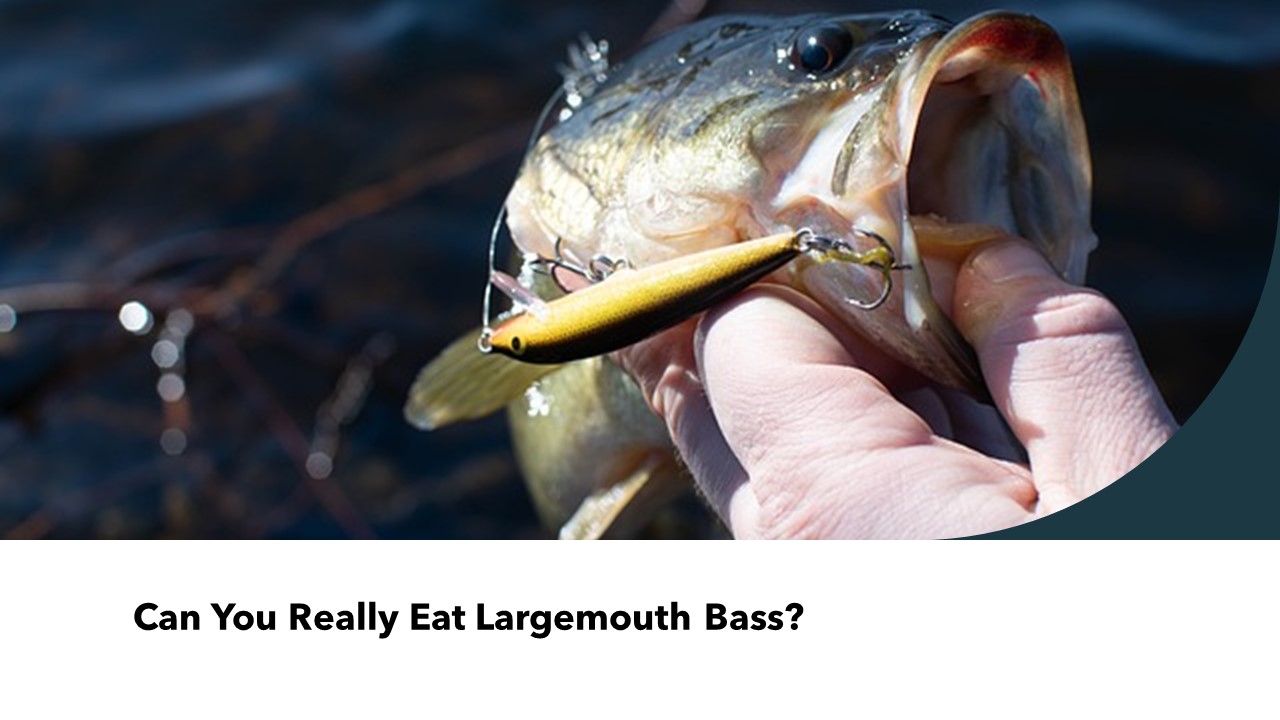If you’re anything like me, you’ve probably found yourself reeling in a big, beautiful largemouth bass on a sunny day out on the water. The excitement of the catch is exhilarating, but have you ever considered whether you can really eat largemouth bass and turn your prized catch into a delectable dish?
The best answer for whether you can really eat largemouth bass is a resounding yes! Largemouth bass can be a delicious culinary experience when prepared and cooked properly.
In this post, I’m diving deep into the question that’s been on the minds of many: Can you really eat largemouth bass? I’ll debunk some common misconceptions, explore the factors that affect its taste, and even share some mouthwatering recipes that will make your taste buds dance with delight.
Let’s uncover the truth and embark on a culinary journey like no other!
Getting to Know Largemouth Bass
Before I dive into the culinary aspects of largemouth bass, let’s take a moment to get acquainted with this fascinating fish.
Largemouth bass, scientifically known as Micropterus salmoides, is a prized freshwater game fish that holds a special place in the hearts of anglers worldwide. You can recognize them by their distinctive greenish coloration, elongated bodies, and, of course, their impressive mouths filled with sharp teeth.
These fish are widely distributed across North America, thriving in various freshwater habitats such as lakes, rivers, and ponds. Whether you’re fishing in the calm waters of a serene lake or battling the current of a lively river, you have a good chance of encountering these formidable fighters.
Now, you might be wondering why largemouth bass are often associated with catch-and-release practices. Well, that’s because they play a crucial role in maintaining a healthy fish population. Many anglers believe in preserving these magnificent creatures for future generations to enjoy. However, it’s important to note that there are circumstances where keeping a fish for consumption is not only permissible but also offers a chance to savor its unique flavors.
But let’s not get ahead of ourselves. Before we indulge our taste buds, let’s address some common misconceptions about the edibility of largemouth bass and explore the factors that can influence their taste and quality.
The Edibility of Largemouth Bass:
There seems to be a prevailing belief that largemouth bass is not suitable for the dinner table. However, let me assure you that this misconception couldn’t be further from the truth. Largemouth bass can indeed be a delectable culinary delight if prepared and cooked properly.
One of the factors that contribute to the perceived taste of largemouth bass is its diet. These fish are opportunistic predators, feeding on a variety of aquatic creatures such as small fish, crayfish, insects, and even frogs. The taste of their flesh can be influenced by what they eat. Bass that feed on a diverse diet of small fish and other natural prey tend to have a clean and pleasant flavor.
Another factor to consider is the water quality in which the bass is caught. Fish living in clean and unpolluted waters generally have better taste and texture compared to those found in polluted environments. So, if you have the opportunity to fish in pristine waters, you’re more likely to enjoy a superior dining experience with your largemouth bass.
Now, I know you may have heard stories of largemouth bass tasting fishy or muddy. While it’s true that improper handling and storage can lead to these undesirable flavors, it’s essential to note that the taste of the fish itself is not inherently fishy or muddy. By following proper cleaning and preparation techniques, you can ensure that your largemouth bass tastes nothing short of fantastic.
Speaking from personal experience, I’ve had the pleasure of cooking and enjoying largemouth bass on numerous occasions. When cleaned and prepared correctly, the fish has a mild, slightly sweet flavor with a firm yet tender texture. It can be truly delightful when seasoned and cooked with care.
In the next sections, I’ll delve into the guidelines for choosing the right fish to eat, the cleaning and preparation process, and even some mouthwatering recipes that will showcase the delicious potential of largemouth bass.
Guidelines for Choosing a Fish to Eat:
When it comes to enjoying largemouth bass as a meal, it’s important to follow some guidelines to ensure that you’re making the best culinary choices. Here are a few factors to consider:
- Fishing regulations and local guidelines: Before you decide to keep a largemouth bass for consumption, familiarize yourself with the fishing regulations and guidelines set by local authorities. These regulations are in place to protect fish populations and promote sustainable fishing practices. Adhering to these guidelines ensures that you’re making responsible choices as an angler and conservationist.
- Size matters: While larger largemouth bass may seem appealing, it’s worth noting that the taste and texture of the fish can vary based on its size. Generally, smaller bass, ranging from one to three pounds, tend to be more desirable for eating. They often have a milder flavor and are more tender compared to larger, older fish. So, if you’re aiming for the best taste experience, consider targeting smaller bass for your culinary endeavors.
- Water quality considerations: The quality of the water where the largemouth bass was caught can significantly impact its taste. Opt for fish that come from clean and unpolluted waters whenever possible. Fishing in well-managed lakes, rivers, or ponds ensures that you’re starting with the best possible ingredient for your meal.
Remember, these guidelines are essential for both the taste of your dish and the overall sustainability of the fish population. By choosing fish responsibly, you contribute to the preservation of this wonderful species for future generations to enjoy.
Next, I’ll dive into the cleaning and preparation process, where I’ll discover how to transform your freshly caught largemouth bass into a delectable feast.
Cleaning and Preparing Largemouth Bass:
Now that you’ve chosen the perfect largemouth bass to enjoy as a meal, it’s time to dive into the cleaning and preparation process. Follow these step-by-step instructions to ensure you have a perfectly cleaned and ready-to-cook fish:
- Gather your tools: You’ll need a fillet knife, cutting board, a bowl of clean water, and a container for discarding the fish waste.
- Start with scaling: Rinse the fish under running water and use the back of your knife or a scaler to remove the scales. Begin at the tail and work your way towards the head, removing scales from both sides of the fish.
- Gutting the fish: Lay the fish on the cutting board and make an incision along the belly, starting from the anus and ending at the throat. Use your fingers or a spoon to carefully remove the innards, being cautious not to puncture the gall bladder. Rinse the cavity thoroughly with clean water.
- Removing the head (optional): If you prefer, you can remove the head of the fish by making a clean cut just behind the gills. This step is optional and depends on your personal preference.
- Filleting the fish: Place the fish on its side and make a vertical cut just behind the gills, running down towards the tail. Use long, smooth strokes with your fillet knife to separate the flesh from the rib bones, guiding the knife along the backbone. Repeat the process on the other side of the fish to obtain two fillets.
- Removing the rib bones: Lay each fillet skin-side down and locate the rib bones. With your fillet knife at a slight angle, carefully slide the knife between the flesh and the rib bones, separating them with smooth, controlled movements. Trim any remaining small bones or connective tissue for a clean fillet.
- Rinse and pat dry: Rinse the fillets with cold water to remove any remaining scales or debris. Pat them dry with a paper towel to remove excess moisture.
Now that you have beautifully cleaned fillets, it’s time to store or cook them. If you plan to cook them immediately, explore the various cooking methods such as grilling, baking, frying, or smoking. The choice is yours, depending on your preferences and culinary creativity.
If you need to store the fillets for later use, place them in an airtight container or wrap them tightly in plastic wrap. They can be refrigerated for up to two days or frozen for longer-term storage. Just make sure to label and date them properly to maintain freshness.
Delicious Recipes to Try:
Now that you have your freshly cleaned and prepared largemouth bass fillets, it’s time to explore some mouthwatering recipes that will elevate your dining experience. Whether you prefer classic flavors or want to experiment with unique culinary creations, these recipes will surely impress your taste buds:
Grilled Largemouth Bass with Citrus Marinade:
- Prepare a marinade using a combination of freshly squeezed citrus juices like lemon, lime, and orange.
- Add minced garlic, a splash of olive oil, and a sprinkle of your favorite herbs such as thyme or parsley.
- Marinate the bass fillets for about 30 minutes, allowing the flavors to infuse into the fish.
- Preheat your grill to medium-high heat and lightly oil the grates.
- Grill the bass fillets for 4-6 minutes per side, or until the fish flakes easily with a fork. Serve with a squeeze of fresh lemon and enjoy the bright, tangy flavors.
Pan-Seared Largemouth Bass with Herbs and Butter
- Season the bass fillets with salt, pepper, and a sprinkle of dried herbs like oregano or dill.
- Heat a tablespoon of butter in a skillet over medium heat until melted and foamy.
- Place the seasoned fillets in the skillet, skin-side down, and cook for 4-5 minutes until the skin is crispy and golden.
- Flip the fillets gently and continue cooking for another 2-3 minutes, basting them with the melted butter.
- Serve the pan-seared bass fillets with a squeeze of fresh lemon juice and a garnish of chopped fresh herbs. The buttery, herb-infused flavors will melt in your mouth.
Bass Chowder
- In a large pot, sauté diced onions, celery, and carrots in a little olive oil until they soften.
- Add diced potatoes, a bay leaf, and your choice of herbs like thyme or rosemary.
- Pour in chicken or vegetable broth and bring the mixture to a boil.
- Reduce the heat to a simmer and add bite-sized pieces of largemouth bass fillets.
- Let the chowder simmer for about 15-20 minutes until the fish is cooked through and the flavors meld together.
- Season with salt, pepper, and a touch of cream for richness. Serve piping hot with crusty bread for a comforting and hearty meal.
These are just a few examples to spark your culinary imagination. Feel free to experiment with different herbs, spices, and sauces to create your own signature largemouth bass dishes. From Cajun-style blackened bass to Asian-inspired steamed bass with ginger and soy sauce, the possibilities are endless.
Safety and Health Considerations:
When it comes to enjoying largemouth bass as a meal, it’s important to prioritize safety and consider certain health factors. Here are 4 key points to keep in mind:
- Mercury levels: Like many other fish, largemouth bass may contain trace amounts of mercury, which can be harmful if consumed in excessive amounts. Mercury accumulates in fish over time, especially in larger and older fish. To minimize your exposure, it’s recommended to consume largemouth bass in moderation, especially if you’re pregnant, nursing, or have young children. Check local advisories or guidelines provided by health authorities to understand the recommended consumption limits for fish in your area.
- Fish advisories and local guidelines: Stay informed about fish advisories and guidelines specific to your region. Local authorities may issue recommendations regarding the consumption of fish from certain bodies of water due to pollution or other environmental concerns. It’s crucial to be aware of any advisories and follow the guidelines to ensure your safety and well-being.
- Allergies and sensitivities: Some individuals may have allergies or sensitivities to fish. If you’re trying largemouth bass for the first time or have a known fish allergy, exercise caution and consult with a healthcare professional if needed. It’s always important to prioritize your health and be aware of any potential allergic reactions.
- Cooking temperatures: When cooking largemouth bass, ensure that the fish reaches a safe internal temperature of 145°F (63°C) to kill any potentially harmful bacteria. Use a food thermometer to accurately measure the temperature and ensure proper cooking.
Remember to balance your enjoyment with responsible consumption and take any necessary precautions based on your specific health needs.
Conclusion
In conclusion, can you really eat largemouth bass? the answer is yes – you can definitely enjoy the culinary delights of largemouth bass. You’ve dispelled misconceptions by exploring the factors that influence taste. You’ve uncovered the true potential of this iconic freshwater fish.
With proper cleaning, preparation, and cooking techniques, largemouth bass can deliver a delicious and memorable dining experience. So, embrace the adventure, savor the flavors, and let your taste buds rejoice in the remarkable world of largemouth bass cuisine.
Until our next adventure, tight lines, and happy eating!
Here’s my most recent post: How Long Can You Keep Fish On Ice? Best Practices For Freshness








